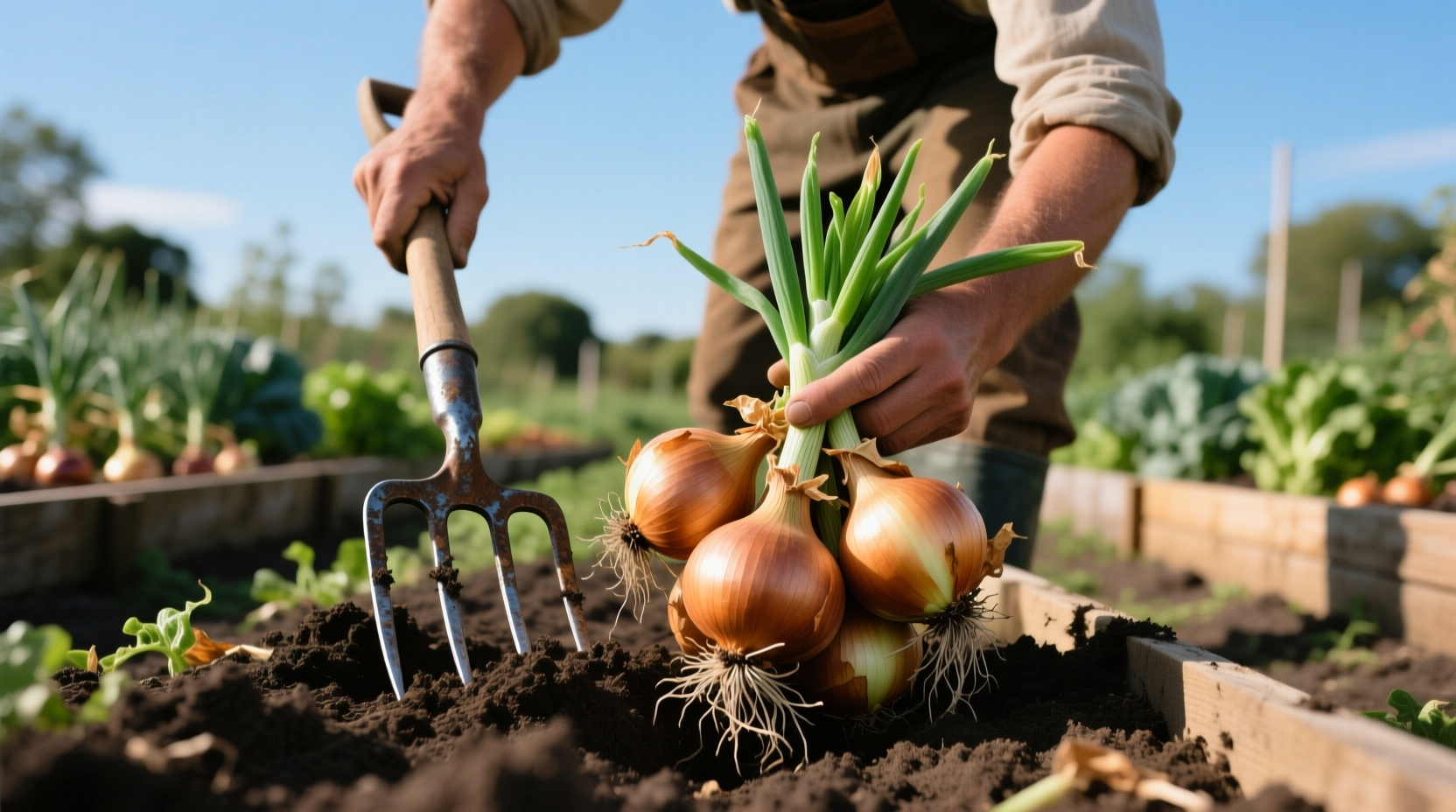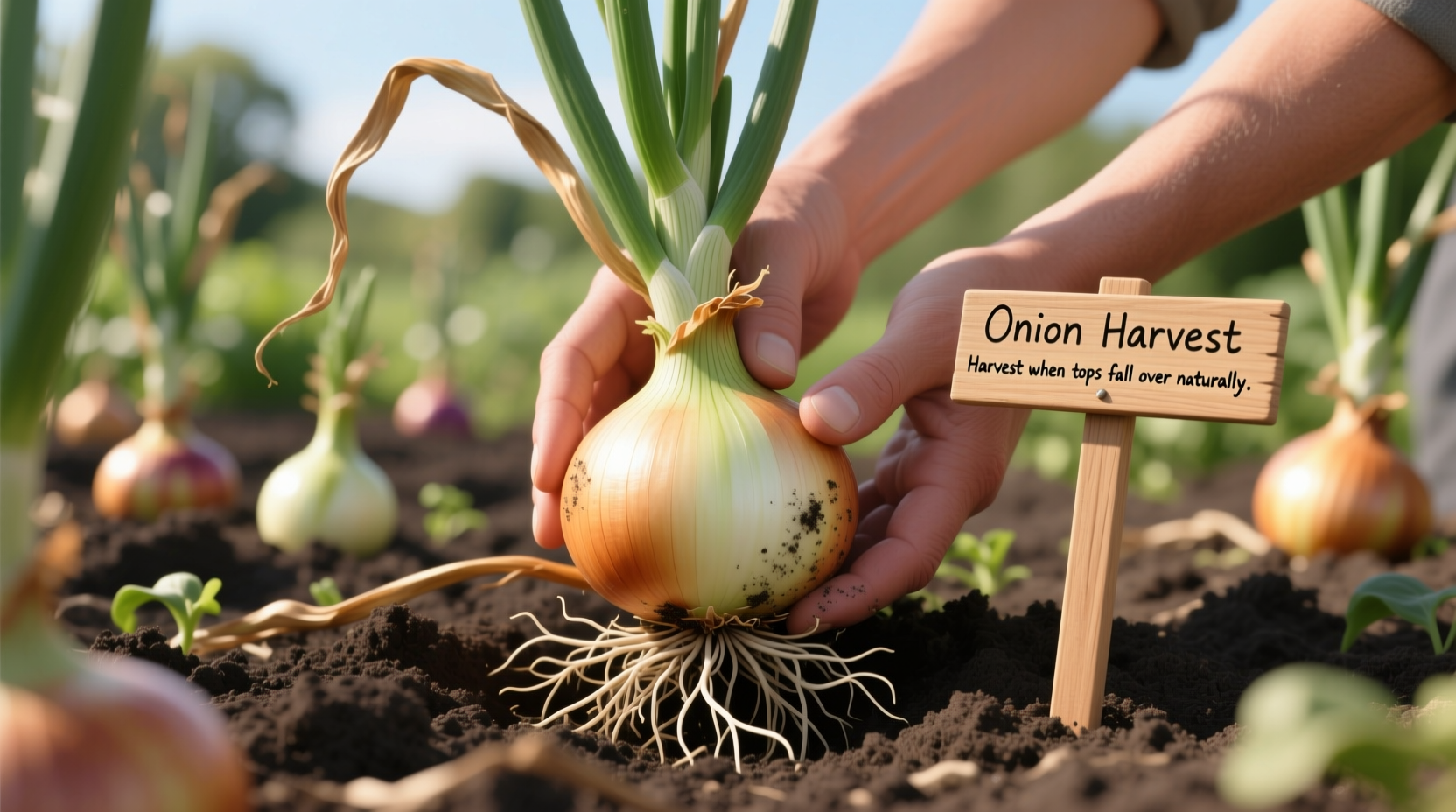Knowing how to harvest an onion properly makes the difference between onions that spoil quickly and those that last through winter. The perfect harvest timing depends on visual cues rather than calendar dates—when the tops naturally fall over and yellow, typically 90-120 days after planting. This signals the bulbs have stopped growing and are ready for harvest. Proper technique prevents damage that leads to rot, while correct curing creates that signature sweet onion flavor and extends storage life significantly.
When Your Onions Are Ready for Harvest
Timing your onion harvest correctly is the most critical factor for long-term storage success. Unlike many vegetables, onions don't continue ripening after harvest—they reach their peak at the moment you pull them from the ground.
Look for these three clear indicators that your onions are ready:
- Fallen tops - When at least 50% of the green tops have naturally fallen over and begun yellowing
- Neck softening - The stem above the bulb becomes soft and begins to collapse
- Bulb maturity - Outer skins turn papery and dry, revealing the characteristic color of your variety
Harvesting too early produces smaller bulbs with poor storage potential, while waiting too long risks bulbs splitting or re-rooting in the soil. The University of California Cooperative Extension confirms that "onions harvested at physiological maturity show the best balance of size, flavor, and storage life" (UC ANR Publication 8503).
| Onion Variety | Days to Maturity | Harvest Timing Indicator | Storage Potential |
|---|---|---|---|
| Yellow Storage Onions | 100-120 days | Tops 75% fallen | 6-8 months |
| Red Onions | 95-110 days | Tops 60% fallen | 4-6 months |
| White Onions | 90-100 days | Tops 50% fallen | 3-4 months |
| Green Onions | 20-30 days | 6" tall with straight tops | 1-2 weeks |
Essential Tools for Harvesting Onions
Having the right tools makes onion harvesting efficient and prevents damage that leads to spoilage. You don't need specialized equipment—most gardeners already have what's required.
Must-have tools:
- Garden fork (preferred over shovel to avoid bulb damage)
- Gloves (onion sap can irritate skin)
- Pruning shears (for trimming roots after curing)
- Sturdy harvesting basket or tray
Helpful additions:
- Soft-bristled brush for gentle soil removal
- Mesh bags or pantyhose for curing and storage
- Weatherproof tarp for field curing

Step-by-Step Onion Harvesting Process
Follow these precise steps for harvesting onions without damage. The entire process takes about 20-30 minutes per 10-foot row.
Step 1: Prepare the Soil (1-2 Days Before Harvest)
Stop watering onions 7-10 days before expected harvest to begin the drying process. If heavy rain is forecast, consider covering your patch with a temporary shelter. On the day before harvest, gently loosen the soil around bulbs with a hand trowel to break any remaining roots.
Step 2: Lift the Bulbs Carefully
Insert your garden fork 6-8 inches away from the bulb row at a 45-degree angle. Gently lever the fork upward to lift the entire clump of onions from the soil. Never pull onions by their tops—this damages the neck and creates entry points for rot. The Royal Horticultural Society recommends "lifting rather than pulling to prevent neck damage which compromises storage life" (RHS Growing Guide).
Step 3: Initial Field Drying
Leave harvested onions in the garden for 24-48 hours to begin the curing process, but only if weather permits. Arrange them in a single layer with tops overlapping to shade the bulbs. If rain threatens, move them immediately to a protected area. This initial drying hardens the outer skin and begins the neck sealing process.
The Critical Curing Process
Curing transforms freshly harvested onions into storage-ready bulbs. This 2-3 week process develops the dry, papery skins that protect against moisture loss and decay.
Optimal curing conditions:
- Temperature: 75-80°F (24-27°C)
- Relative humidity: 70-80%
- Air circulation: Constant gentle breeze
- Light: Dry, shaded area (not direct sun)
Monitor your curing onions daily. The process is complete when:
- The neck is completely dry and tight
- Outer skins are crisp and papery
- Roots are dry and brittle
Avoid common curing mistakes: bringing onions directly indoors (traps moisture), exposing to rain, or stacking too deeply (reduces air circulation).
Proper Storage Techniques for Maximum Shelf Life
After curing, prepare your onions for long-term storage with these professional techniques:
- Trimming: Cut tops to 1 inch above the bulb using sharp shears. Never cut flush with the bulb.
- Root removal: Trim roots to ¼ inch. Don't pull them out, as this can damage the base.
- Sorting: Remove any bulbs with soft spots, cuts, or thick necks—they won't store well.
- Storage containers: Use mesh bags, woven baskets, or pantyhose with knots between bulbs.
Store onions in a cool, dark, dry place with good air circulation. Ideal conditions are 32-40°F (0-4°C) with 65-70% humidity. Under these conditions, properly cured storage onions will last 6-8 months. The USDA notes that "onions stored at 32°F with 65-70% relative humidity show minimal weight loss and sprouting through 8 months" (USDA Postharvest Technology).
Common Harvesting Mistakes and How to Avoid Them
Even experienced gardeners make these preventable errors that compromise onion quality and storage life:
- Harvesting in wet conditions: Never harvest after rain or when dew is heavy. Moisture promotes mold and rot. Wait until bulbs are completely dry.
- Skipping the field drying: Moving onions directly indoors traps moisture in the neck, creating perfect conditions for decay.
- Improper curing temperatures: Temperatures below 50°F slow curing; above 90°F can cause premature sprouting.
- Storing near ethylene producers: Keep onions away from apples, bananas, and potatoes which release ethylene gas that promotes sprouting.
Gardeners consistently report that the most challenging aspect is determining exact harvest timing. A survey of 500 home gardeners by the National Gardening Association found that 68% harvested onions too early at least once, resulting in reduced storage life. The most successful growers rely on visual indicators rather than calendar dates.
Troubleshooting Your Onion Harvest
Encountering problems with your onion harvest? These solutions address common issues:
- Split bulbs: Caused by irregular watering late in the season. Harvest immediately and use first.
- Thick necks: Result from excess nitrogen or immature bulbs. These won't store well—use within weeks.
- Mold during curing: Indicates high humidity or poor air circulation. Move to a drier location immediately.
- Early sprouting: Caused by improper storage temperature. Move to a cooler location.
Remember that regional climate variations affect harvesting timing. Gardeners in warmer zones (USDA 8-10) often harvest earlier than calendar dates suggest, while cooler zones (USDA 3-5) may need additional curing time indoors due to shorter dry seasons.











 浙公网安备
33010002000092号
浙公网安备
33010002000092号 浙B2-20120091-4
浙B2-20120091-4